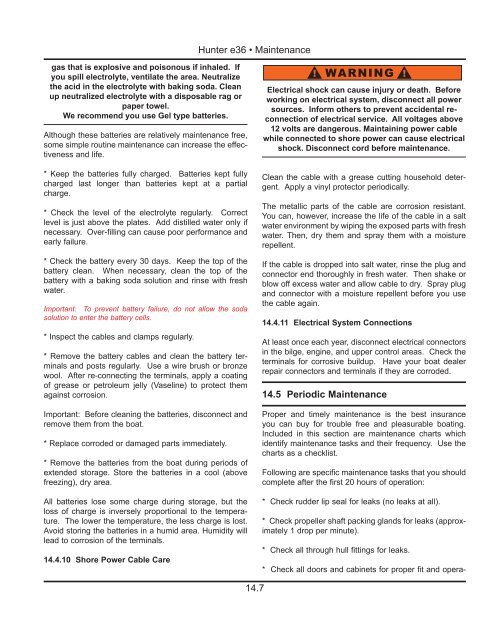36e Operator's Manual 2013.pdf - Marlow-Hunter, LLC
36e Operator's Manual 2013.pdf - Marlow-Hunter, LLC
36e Operator's Manual 2013.pdf - Marlow-Hunter, LLC
- No tags were found...
Create successful ePaper yourself
Turn your PDF publications into a flip-book with our unique Google optimized e-Paper software.
<strong>Hunter</strong> e36 • Maintenancegas that is explosive and poisonous if inhaled. Ifyou spill electrolyte, ventilate the area. Neutralizethe acid in the electrolyte with baking soda. Cleanup neutralized electrolyte with a disposable rag orpaper towel.We recommend you use Gel type batteries.Although these batteries are relatively maintenance free,some simple routine maintenance can increase the effectivenessand life.* Keep the batteries fully charged. Batteries kept fullycharged last longer than batteries kept at a partialcharge.* Check the level of the electrolyte regularly. Correctlevel is just above the plates. Add distilled water only ifnecessary. Over-filling can cause poor performance andearly failure.* Check the battery every 30 days. Keep the top of thebattery clean. When necessary, clean the top of thebattery with a baking soda solution and rinse with freshwater.Important: To prevent battery failure, do not allow the sodasolution to enter the battery cells.* Inspect the cables and clamps regularly.* Remove the battery cables and clean the battery terminalsand posts regularly. Use a wire brush or bronzewool. After re-connecting the terminals, apply a coatingof grease or petroleum jelly (Vaseline) to protect themagainst corrosion.Important: Before cleaning the batteries, disconnect andremove them from the boat.* Replace corroded or damaged parts immediately.* Remove the batteries from the boat during periods ofextended storage. Store the batteries in a cool (abovefreezing), dry area.All batteries lose some charge during storage, but theloss of charge is inversely proportional to the temperature.The lower the temperature, the less charge is lost.Avoid storing the batteries in a humid area. Humidity willlead to corrosion of the terminals.14.4.10 Shore Power Cable Care! WARNING !Electrical shock can cause injury or death. Beforeworking on electrical system, disconnect all powersources. Inform others to prevent accidental reconnectionof electrical service. All voltages above12 volts are dangerous. Maintaining power cablewhile connected to shore power can cause electricalshock. Disconnect cord before maintenance.Clean the cable with a grease cutting household detergent.Apply a vinyl protector periodically.The metallic parts of the cable are corrosion resistant.You can, however, increase the life of the cable in a saltwater environment by wiping the exposed parts with freshwater. Then, dry them and spray them with a moisturerepellent.If the cable is dropped into salt water, rinse the plug andconnector end thoroughly in fresh water. Then shake orblow off excess water and allow cable to dry. Spray plugand connector with a moisture repellent before you usethe cable again.14.4.11 Electrical System ConnectionsAt least once each year, disconnect electrical connectorsin the bilge, engine, and upper control areas. Check theterminals for corrosive buildup. Have your boat dealerrepair connectors and terminals if they are corroded.14.5 Periodic MaintenanceProper and timely maintenance is the best insuranceyou can buy for trouble free and pleasurable boating.Included in this section are maintenance charts whichidentify maintenance tasks and their frequency. Use thecharts as a checklist.Following are specific maintenance tasks that you shouldcomplete after the first 20 hours of operation:* Check rudder lip seal for leaks (no leaks at all).* Check propeller shaft packing glands for leaks (approximately1 drop per minute).* Check all through hull fittings for leaks.* Check all doors and cabinets for proper fit and opera-14.7

















